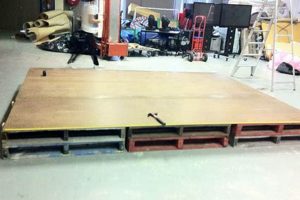The practice of crafting items through do-it-yourself methods using reclaimed wooden shipping platforms represents a growing trend in both hobbyist and practical applications. These platforms, commonly known as pallets, are disassembled, repurposed, and transformed into furniture, decorative elements, and structural components. For example, individuals create coffee tables, headboards, wall art, and even garden planters using these readily available materials.
The appeal lies in several factors, including cost-effectiveness, sustainability, and creative expression. Utilizing reclaimed wood reduces waste and offers an environmentally conscious alternative to purchasing new materials. The use of readily accessible materials decreases expenses, particularly for individuals with limited budgets. Furthermore, the inherent rustic aesthetic of the wood adds a unique character to projects, allowing for personalized designs and artisanal craftsmanship. Historically, resourcefulness and material repurposing have been integral to human innovation, and this current trend echoes that tradition.
Subsequent sections will delve into the considerations for selecting appropriate pallets, safe handling practices, and various techniques for cutting, joining, and finishing the wood to achieve desired outcomes. Further discussion will explore specific project ideas, addressing design considerations, construction methods, and necessary tools for successful implementation.
Essential Tips for Repurposing Wooden Shipping Platforms
Successful repurposing of wooden shipping platforms necessitates careful planning and execution. The following guidelines aim to optimize project outcomes and ensure structural integrity.
Tip 1: Sourcing and Selection: Prioritize platforms designated as HT (Heat Treated) to minimize chemical contamination. Avoid those marked with “MB” (Methyl Bromide) due to toxicity concerns. Inspect each platform for structural damage, excessive wear, and signs of infestation before acquisition.
Tip 2: Safe Disassembly: Employ appropriate safety equipment, including gloves and eye protection, during disassembly. Utilize specialized tools designed for nail and staple removal to minimize wood splitting. Consider utilizing a reciprocating saw for efficient board separation.
Tip 3: Wood Preparation: Thoroughly clean the wood surfaces with soap and water to remove dirt, grime, and potential contaminants. Allow the wood to dry completely before proceeding. Sanding rough surfaces and edges is essential for both aesthetic appeal and safety.
Tip 4: Design Considerations: Develop a detailed plan or blueprint prior to commencing construction. Account for wood dimensions, structural support requirements, and intended use. Implement appropriate joinery techniques for secure connections.
Tip 5: Secure Fastening: Utilize screws rather than nails for increased structural stability. Countersink screw heads to create a flush surface and prevent snagging. Apply wood glue to joints for enhanced bonding strength.
Tip 6: Finishing and Sealing: Apply a suitable finish to protect the wood from moisture, UV damage, and wear. Consider using a sealant to prevent splintering and enhance durability. Select finishes appropriate for the intended use, prioritizing non-toxic options for indoor applications.
Tip 7: Legal and Ethical Considerations: Confirm ownership of the platform prior to disassembly and repurposing. Adhere to all local regulations regarding waste disposal and material reclamation. Respect intellectual property rights when replicating existing designs.
Following these tips promotes safe, efficient, and aesthetically pleasing outcomes when transforming wooden shipping platforms. Careful attention to detail and adherence to sound construction principles are paramount to achieving lasting results.
The subsequent section will address advanced techniques and explore innovative project ideas for further engagement with this versatile material.
1. Sourcing safe pallets
The procurement of wooden shipping platforms suitable for do-it-yourself projects is contingent upon identifying and securing sources of inherently safe materials. Inadequate attention to the origin and treatment of these platforms introduces potential health risks and compromises the structural integrity of finished goods.
- Heat Treatment Identification
Pallets marked with the “HT” designation indicate heat treatment, a method used to eliminate pests without chemical applications. This is generally considered a safer alternative to chemical fumigation. Conversely, pallets lacking this designation, or those bearing “MB” (methyl bromide) markings, should be avoided due to the potential for toxic residue. Accurate identification requires careful inspection of pallet markings, typically found on the stringers or blocks.
- Visual Inspection for Contamination
A thorough visual inspection is essential in assessing the safety of a potential platform. Look for signs of staining, discoloration, or unusual odors, which may indicate chemical spills or contamination. Avoid pallets that appear excessively weathered, rotted, or exhibit signs of mold growth. These conditions can compromise structural integrity and pose health hazards.
- Source Reliability Assessment
The reliability of the source from which pallets are obtained directly impacts safety. Reputable pallet suppliers maintain quality control measures and can provide information regarding treatment methods and past uses. Avoid sourcing pallets from unknown or unregulated sources, such as roadside piles or abandoned industrial areas, as these platforms may have been exposed to unknown contaminants. Verifying the source’s history and practices is crucial.
- Understanding Pallet Grades
Pallet grading systems categorize platforms based on their condition and intended use. While grading does not directly guarantee safety, it offers insight into the level of wear and potential for damage. “Grade A” pallets typically represent the highest quality, while lower grades may exhibit more damage or require extensive repairs. Selecting pallets appropriate for the intended project scope and understanding the grading system contributes to a safer and more efficient construction process.
Prioritizing safety when acquiring wooden shipping platforms for do-it-yourself ventures mitigates potential risks associated with chemical exposure and structural compromise. By adhering to these guidelines, individuals can ensure that projects are not only aesthetically pleasing but also safe for their intended use and environment. Neglecting these aspects can lead to long-term health consequences and structural failures, underscoring the importance of diligence in the initial sourcing phase.
2. Proper Disassembly Techniques
The effective and safe deconstruction of wooden shipping platforms is a critical prerequisite for successful do-it-yourself projects involving reclaimed wood. Improper disassembly techniques introduce the risk of material damage, personal injury, and project failure. The structural integrity of the resultant components is directly contingent upon the methods employed during the initial breakdown of the pallet.
The selection of appropriate tools and adherence to specific procedures are paramount. For instance, the use of a reciprocating saw with a metal-cutting blade allows for efficient removal of fasteners while minimizing wood splitting, a common occurrence when using pry bars alone. Implementing safety protocols such as wearing eye protection and gloves reduces the likelihood of injuries from flying debris or sharp edges. Furthermore, recognizing and avoiding common disassembly pitfalls, such as attempting to force stubborn fasteners, prevents damage to the wood and reduces the risk of accidents. A well-executed disassembly preserves the usability of the reclaimed lumber and contributes directly to the feasibility and aesthetic quality of the final product. A common error is trying to pry boards without cutting through the nails first, resulting in breakage and unusable wood.
Ultimately, the skillful application of proper disassembly techniques significantly influences the outcome of any do-it-yourself project utilizing reclaimed wooden shipping platforms. Attention to detail, combined with a focus on safety and material preservation, ensures a higher quality end product and minimizes the potential for setbacks. Mastering these techniques represents a fundamental step in the successful repurposing of these ubiquitous materials.
3. Effective Wood Preparation
Effective wood preparation is an indispensable component of successful do-it-yourself projects utilizing reclaimed wooden shipping platforms. The condition of the wood directly influences the structural integrity, aesthetic appeal, and longevity of the finished product. Neglecting proper preparation can lead to a range of issues, including uneven surfaces, splintering, susceptibility to moisture damage, and premature deterioration. The preparation process encompasses cleaning, sanding, and moisture control, each contributing to the overall quality of the project. For instance, failure to adequately clean the wood can result in poor adhesion of finishes, while insufficient sanding leaves surfaces rough and prone to splintering. Proper preparation converts rough and potentially hazardous materials into usable, attractive components.
One critical step involves moisture content management. Reclaimed wood often exhibits varying moisture levels, depending on its storage and previous use. Allowing the wood to acclimate to the project environment and employing techniques to equalize moisture content minimizes warping and cracking after construction. This process might involve storing the wood indoors for a period of time or utilizing a dehumidifier. The selection of appropriate finishes also hinges on the wood’s moisture content; applying finishes to excessively damp wood can trap moisture, leading to blistering and peeling. The application of wood filler to repair cracks and imperfections is also essential; however, its effectiveness is contingent on the wood’s cleanliness and dryness. In situations where wood is excessively damaged, consolidation with epoxy resins can strengthen weakened areas prior to further processing, preserving the character of the wood while enhancing its structural properties.
In conclusion, effective wood preparation is not merely a preliminary step but an integral aspect of crafting with reclaimed wooden shipping platforms. Diligence in cleaning, sanding, and managing moisture content yields improved project outcomes. The challenges associated with working with reclaimed wood are mitigated through careful preparation. The transformation of discarded materials into functional and aesthetically pleasing items hinges on the recognition and application of appropriate wood preparation techniques. By prioritizing preparation, individuals can maximize the potential of reclaimed materials, producing durable and visually appealing creations.
4. Project Design Planning
Project design planning serves as a foundational element within the broader scope of do-it-yourself initiatives utilizing reclaimed wooden shipping platforms. The absence of methodical planning frequently results in inefficient material utilization, structural deficiencies, and deviations from the intended aesthetic. A well-defined design plan acts as a blueprint, guiding the construction process and minimizing errors. For instance, constructing a coffee table without precise measurements and joinery specifications can lead to an unstable and visually unappealing final product. Conversely, a carefully considered plan, including sketches, dimensions, and material lists, allows for a streamlined and successful build. The relationship is causal: inadequate planning increases the probability of project failure, while thorough planning enhances the likelihood of a satisfactory outcome. The effective management of time, materials, and resources necessitates a pre-determined course of action, underscoring the practical significance of project design planning.
Practical application of project design principles includes conducting a thorough assessment of the available pallet wood, categorizing pieces by size, condition, and potential use. This inventory informs the design, allowing for optimal material allocation and minimizing waste. Furthermore, design plans should account for the specific characteristics of pallet wood, such as nail holes, variations in grain, and potential imperfections, integrating these features into the overall aesthetic rather than attempting to eliminate them. The incorporation of digital modeling software allows for visualizing the final product and identifying potential structural weaknesses before physical construction commences. An example of practical application includes designing a vertical garden, where the design plan dictates the dimensions of the planters, the spacing between them, and the integration of a watering system, maximizing space utilization and plant health.
In summary, project design planning is an integral and indispensable phase of do-it-yourself projects utilizing reclaimed wooden shipping platforms. The challenges inherent in working with reclaimed materials, such as dimensional inconsistencies and structural variations, are effectively addressed through meticulous planning. The connection between thorough design and project success is direct and demonstrably significant. The broader theme of sustainable resource utilization is amplified by the efficient and responsible practices promoted by thoughtful project design.
5. Joinery and Assembly
The integrity and longevity of do-it-yourself projects utilizing reclaimed wooden shipping platforms are intrinsically linked to the methods of joinery and assembly employed. Selecting appropriate joinery techniques and executing sound assembly practices determine the structural stability and aesthetic quality of the finished article.
- Screw Fastening Techniques
The use of screws, as opposed to nails, is generally favored in pallet wood projects due to their superior holding power. Pilot holes are critical to prevent wood splitting, particularly when working with seasoned or brittle pallet wood. Countersinking screw heads ensures a flush surface, preventing snagging and enhancing the finished appearance. The selection of appropriate screw length is essential for secure connections without protruding beyond the joined members.
- Wood Glue Application
The application of wood glue in conjunction with mechanical fasteners augments joint strength and reduces the likelihood of movement over time. Prior to assembly, surfaces must be clean and free of debris to ensure optimal glue adhesion. Clamping is necessary to maintain consistent pressure during the glue’s curing process. Excess glue should be removed promptly to prevent unsightly residue. The type of glue selected must be appropriate for the intended application and environmental conditions.
- Butt Joints and Reinforcement
Butt joints, while simple to execute, inherently lack strength and require reinforcement in pallet wood projects. Reinforcement methods include the use of metal plates, wooden cleats, or pocket screws. Proper alignment and secure fastening are critical for butt joint stability. The strategic placement of reinforcement elements enhances the load-bearing capacity of the joint, preventing premature failure. Consider using different joints.
- Joinery Alternatives: Mortise and Tenon Considerations
While more complex to execute, traditional joinery methods such as mortise and tenon joints offer superior strength and aesthetic appeal. Modifying these techniques for use with reclaimed pallet wood requires precision and careful planning. The selection of appropriate wood species and grain orientation enhances the integrity of the joint. A well-executed mortise and tenon joint provides a robust and visually appealing connection, elevating the overall quality of the finished piece.
The successful integration of appropriate joinery and assembly methods is paramount to realizing the full potential of reclaimed wooden shipping platforms in do-it-yourself projects. Adherence to sound construction principles and careful attention to detail ensures durable, aesthetically pleasing, and structurally sound outcomes. Ignoring these considerations compromises the viability and longevity of any project utilizing this versatile material.
6. Finishing for Durability
The durability of do-it-yourself projects constructed from reclaimed wooden shipping platforms is fundamentally dependent on the selection and application of appropriate finishing techniques. Reclaimed wood, by its nature, has often been exposed to environmental stressors and exhibits varying degrees of wear. Consequently, finishing serves not only to enhance aesthetic appeal but, more crucially, to protect the wood from moisture, ultraviolet radiation, abrasion, and biological degradation. The absence of a protective finish compromises the structural integrity and reduces the lifespan of the constructed item. For example, an outdoor bench made from pallet wood without a weather-resistant finish will quickly succumb to rot and structural failure, whereas a properly finished bench can withstand years of exposure. The effectiveness of the finish dictates the long-term viability of the project, underscoring its status as an indispensable component.
The practical application of finishing techniques requires careful consideration of the intended use and environmental conditions to which the finished item will be subjected. Exterior applications necessitate finishes with ultraviolet inhibitors and water-repellent properties, such as marine-grade varnishes or penetrating oil finishes. Interior applications may benefit from film-forming finishes like polyurethane, which provide a durable, scratch-resistant surface. Proper surface preparation, including sanding and cleaning, is essential to ensure adequate adhesion of the finish. Multiple coats are typically required to achieve optimal protection, with each coat properly cured before the subsequent application. The selection of non-toxic finishes is particularly important for items intended for indoor use or contact with food.
In summary, finishing for durability constitutes an essential aspect of do-it-yourself projects involving reclaimed wooden shipping platforms. Neglecting this stage results in diminished structural integrity and reduced product lifespan. The selection and application of appropriate finishing techniques, tailored to the intended use and environmental conditions, are paramount to maximizing the durability and aesthetic appeal of projects constructed from reclaimed pallet wood. The successful integration of finishing techniques reinforces the principles of sustainability and resourcefulness inherent in the practice of repurposing discarded materials. The ongoing challenge lies in balancing aesthetic considerations with the imperative of long-term protection, ensuring the durability of constructed items.
7. Safe working practices
The intersection of safe working practices and do-it-yourself projects involving reclaimed wooden shipping platforms represents a critical area of consideration. The reuse of pallets introduces inherent risks associated with handling potentially contaminated or structurally compromised materials. Failure to adhere to established safety protocols can lead to injuries, exposure to harmful substances, and project failures. For example, improper handling of a pallet may result in splinters, cuts, or musculoskeletal strains. Likewise, neglecting to wear respiratory protection during sanding or cutting operations can lead to the inhalation of wood dust and potential exposure to chemicals. Consequently, a comprehensive understanding and application of safety measures are essential components of any successful do-it-yourself project utilizing reclaimed wooden shipping platforms. The adoption of safe working practices functions as a direct mitigant against the hazards associated with this specific activity, establishing a causal relationship between safety adherence and positive project outcomes.
The practical application of safe working practices encompasses several key areas. First, a thorough inspection of the pallet wood is necessary to identify potential hazards, such as protruding nails, splinters, or signs of chemical contamination. Second, the use of appropriate personal protective equipment (PPE), including safety glasses, gloves, and respiratory protection, is mandatory during all phases of the project. Third, the selection and proper use of tools, such as saws, drills, and sanders, are critical to minimizing the risk of injury. Fourth, maintaining a clean and organized workspace reduces the likelihood of accidents. Fifth, awareness of potential allergenic reactions to certain types of wood is also a factor; users are advised to determine the wood species and any potential allergenic threats. Each of these practices contributes directly to a safer working environment. Furthermore, a clear understanding of the mechanical properties of wood, including its tendency to split or crack under stress, informs the selection of appropriate joinery techniques and fastener types.
In summary, safe working practices are not merely an optional addendum but rather an integral and indispensable aspect of do-it-yourself projects involving reclaimed wooden shipping platforms. The challenges associated with handling potentially hazardous materials and utilizing power tools necessitate a rigorous adherence to safety protocols. The proactive implementation of safety measures significantly reduces the risk of injury, exposure to harmful substances, and project failures. The broader theme of responsible resource utilization is enhanced by prioritizing the safety and well-being of individuals engaged in do-it-yourself activities, contributing to a culture of safety and craftsmanship.
Frequently Asked Questions
The following addresses common inquiries regarding the use of reclaimed wooden shipping platforms in do-it-yourself projects. The intent is to provide clarity and guidance on frequently encountered concerns.
Question 1: How does one determine the safety of a wooden shipping platform for repurposing?
The presence of an “HT” (Heat Treated) stamp indicates a safer option, as the pallet was treated with heat rather than chemicals. Pallets marked “MB” (Methyl Bromide) should be avoided due to potential toxicity. Visual inspection for stains, spills, or unusual odors is also recommended.
Question 2: What are the essential safety precautions during pallet disassembly?
Eye protection and gloves are mandatory. A reciprocating saw with a metal-cutting blade is recommended for nail removal to minimize splitting. Ensure adequate ventilation to mitigate the inhalation of dust or potential contaminants.
Question 3: What is the recommended procedure for preparing pallet wood for use?
Cleaning with soap and water removes dirt and grime. Thorough sanding eliminates rough edges and splinters. Allow the wood to dry completely before applying finishes. Repair any imperfections with appropriate wood filler.
Question 4: How can structural integrity be ensured in pallet wood projects?
Screws provide superior holding power compared to nails. Wood glue enhances joint strength. Reinforcement elements, such as metal plates or wooden cleats, are necessary for butt joints. Careful planning of joinery is crucial.
Question 5: What type of finish is best suited for outdoor pallet wood projects?
Finishes with ultraviolet inhibitors and water-repellent properties are essential for outdoor applications. Marine-grade varnishes and penetrating oil finishes offer adequate protection against weathering.
Question 6: How does one address concerns regarding potential chemical exposure from pallet wood?
Sourcing pallets from reputable suppliers who can provide information on treatment methods is advisable. Thorough cleaning and sanding help remove surface contaminants. Sealing the wood with a non-toxic finish minimizes direct contact.
In summary, awareness of potential risks, adherence to safety protocols, and proper preparation are paramount when working with reclaimed wooden shipping platforms. This approach promotes safe and successful project outcomes.
The next article section will delve into innovative project ideas incorporating advanced techniques.
Conclusion
The preceding analysis has illuminated the multifaceted aspects of diy with pallet wood, encompassing sourcing, preparation, construction, and safety. Emphasis has been placed on the importance of material selection, adherence to safe working practices, and the application of appropriate techniques to ensure structural integrity and longevity in finished projects.
The responsible repurposing of discarded wooden shipping platforms presents both opportunities and challenges. Continued diligence in sourcing safe materials and refining construction methods remains paramount. The long-term success of diy with pallet wood as a sustainable practice hinges upon a commitment to safety, craftsmanship, and environmental responsibility. Further research and innovation in joinery techniques and finishing materials will undoubtedly enhance the durability and aesthetic appeal of future creations. The field necessitates ongoing education and a commitment to sharing best practices within the community of practitioners.





![[DIY Guide] Easy DIY Wood Window Shutters You Can Build! The DIY Hub: Creative Crafts, Repairs & Life Hacks [DIY Guide] Easy DIY Wood Window Shutters You Can Build! | The DIY Hub: Creative Crafts, Repairs & Life Hacks](https://craftingdiycenter.com/wp-content/uploads/2025/07/th-3579-300x200.jpg)

